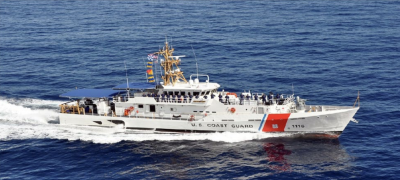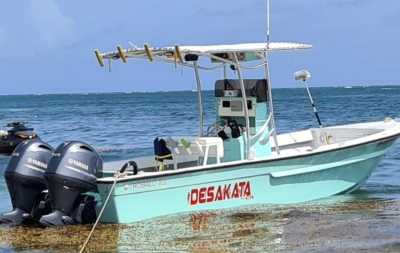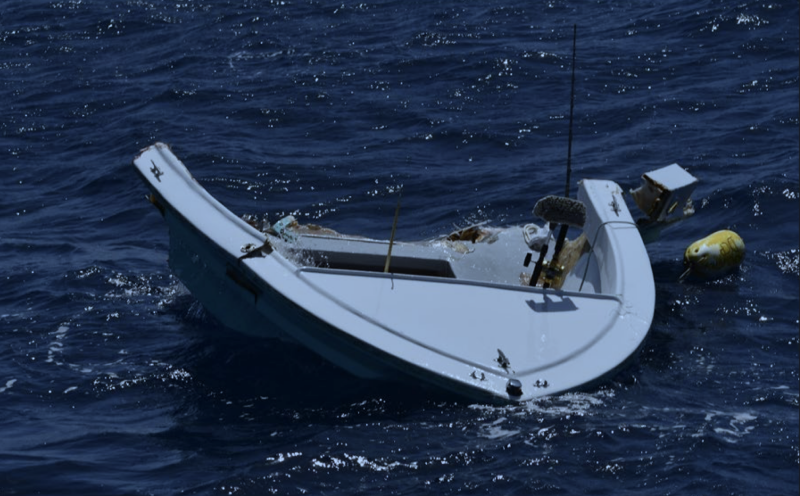A fatal collision last year between a Coast Guard cutter and small fishing boat off Puerto Rico resulted from the crews of both vessels failing to maintain a proper lookout, according to a new National Transportation Safety Board report on the accident.
The Winslow Griesser, a 154-foot fast response cutter, and the Desakata, a 23-foot center console boat, collided four miles off Dorado, Puerto Rico, Aug. 8, 2022, resulting in the death of fisherman Carlos Rosario and injuries to his brother Samuel Rosario Beltrán, and the loss of the Desakata. None of the Griesser’s crew were injured in the collision.
NTSB investigators found that the bridge crew on the Winslow Griesser was not aware they had hit anything, until a crewmember saw the center-console boat’s wreckage floating down the side of the cutter around 2:17 p.m.
“Maintaining a proper lookout, by sight and sound, is a fundamental rule of the Convention on the International Regulations for Preventing Collision at Sea for vessels,” the NTSB said in introducing its findings. The agency also called on the Coast Guard to install voyage data recorders on its cutters, which would have aided investigators in reconstructing the accident sequence.
The agency’s report notes that three ranking crew members – then-vessel commander Lt. Cmdr. Benjamin Williamsz, the officer of the deck, and quartermaster of the watch – declined investigators’ requests for interviews based on advice of their legal counsel.
Williamsz was relieved in February 2023 by Rear Adm. Brendan C. McPherson, commander of the Seventh Coast Guard District based in Miami, “due to a loss of confidence in Williamsz’s ability to effectively command the cutter,” the Coast Guard said at the time.
In their report NTSB investigators say that “had the Winslow Griesser been equipped with a voyage data recorder, or its equivalent, investigators would have been provided with additional critical factual information about the collision, which could help identify potential safety issues and result in safety improvements.”

The agency also issued a safety alert encouraging owners of recreational boats and small commercial fishing vessels to install radar reflectors and use simplified automatic identification system (AIS) transponders to improve their boats’ detectability by other vessels.
“The NTSB continues to investigate tragedies like this collision in which vessels are not maintaining proper lookout,” NTSB Chair Jennifer Homendy said in announcing release of the report. “Early detection of a vessel is critical to avoiding a collision. While technology does not remove the need to maintain a proper lookout, it can aid in early detection, which is why we are issuing a safety alert for small vessels to encourage installing a radar reflector and/or an automatic identification system transponder to improve their detectability.”
In the minutes before the collision, neither the Coast Guard crew nor the fishermen on the Desakata saw the other vessel approaching. The fishermen were focused on their lines trolling for fish, according to the NTSB investigators who interviewed the survivor, while no one on the cutter’s bridge was designated as a lookout with no other duties.

“Coast Guard practice is that all members of the bridge watch are responsible for shared lookout duties,” according to the NTSB. “Investigators determined no one was maintaining a lookout at the time of the collision.
“Contributing factors, investigators said, included the failure of the Winslow Griesser’s commanding officer and officer of the deck to take sufficient measures to increase situational awareness while the cutter was traveling at a high speed.”
Weather forecasts late on the morning of Aug. 8 called for 15– to 20-knot easterly winds and 4- to 6-foot seas with occasional 8-foot seas. The NTSB investigators had an eyewitness who was on a flight from Miami to San Juan and noticed the two vessels.
“As the aircraft approached the coastline near Dorado, Puerto Rico, from an altitude of about 5,000 feet, he observed both vessels traveling on a constant heading. He described the Winslow Griesser, assuming it was a naval vessel, as proceeding ‘pretty fast’ and the Desakata as ‘struggling because of the waves’ and ‘going fairly slow’ though ‘moving the whole time.’”
The cutter was proceeding at 29 knots with seas and swells from astern, according to the report. The Griesser is equipped with 16 close-circuit video cameras, and one on the cutter’s mast captured an image of the the Desakata about 19 seconds before the collision, crossing from port to starboard at a near right angle roughly 10° off the bow.
“The camera footage, which was not clear because of a salt-crusted lens, appeared to show the Desakata disappearing and reappearing in the waves a few times,” the report says. “Camera footage also showed the Winslow Griesser yawing to port and starboard in following seas.”
At 2:17 p.m. the mast video camera showed the collision, and “crewmembers on the cutter’s mess deck, located on the main deck below the bridge, felt a shudder and heard a bang,” the report says. “One crewmember stated that he thought they hit a whale. Onboard cameras captured the crew’s reaction to the collision on the mess deck and other crewmembers checking for damage in the engine room.”
On deck, a crewmember taking a break behind the bridge saw wreckage drift down the cutter’s port side, and reported to the bridge watch members who had not realized the cutter had struck anything, the report says.
From 5,000 feet up, the airline passenger told investigators, the vessels had “proceeded on constant headings until the ‘cutter passes [sic] on top of the boat,’” the report says. “He stated that it was ‘like they were on a collision course [the whole time] and didn’t know it.’”
The Desakata split in two on impact, and the cutter crew saw its owner Samuel Rosario Beltrán waving to them amid the wreckage and holding on to his brother. The Coast Guard crew maneuvered the Griesser alongside, putting down life rings and a Jacob’s ladder while readying the cutter’s small boat and a rescue swimmer.
The Desakata’s captain could not climb the ladder in rough seas, so the cutter’s coxswain maneuvered the small boat and the owner swam toward it pulling his brother. Back on board the cutter, the crew treated the captain for a head injury, and found his brother had died.
“As the only independent investigator of U.S. Coast Guard casualties, it is vital that NTSB investigators have information from voyage data recorders or equivalent capabilities to ensure a complete, timely and thorough investigation,” said Homendy of the NTSB. “Voyage data recorders, like black boxes in airplanes, are one of the most valuable sources of information following a marine casualty and it is imperative that Coast Guard cutters be equipped with this technology.”







